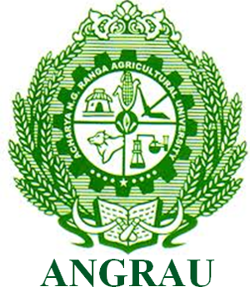Status of Handloom Artisans & Marketing Constraints: A Study in the West Tripura, India
0 Views
SUJOY HAZARI*, MAMONI KALITA, BHARGABI CHAKRABORTY AND ANAMIKA DEBNATH
The ICFAI University Tripura, Kamalghat-799210.
ABSTRACT
The handloom industry is both a traditional and a cottage industry in India, employing a large number of indigenous rural people. Tripura’s people consider weaving to be an integral part of their lives and they produce a variety of crafts. Out of the different crafts, handloom is one of the primary crafts in Tripura. Handloom provides livelihood opportunities for rural people, including a large number of indigenous women and people from disadvantaged social groups. Despite all these opportunities, the handloom sector still faces lots of constraints and challenges. Thus, the current research is about the socio-economic condition of handloom artisans in Tripura and also identifies the artisans’ consultants and challenges. The study was conducted in the region of sixteen villages in the Hezamara, Belbari, Mandai, and Lefunga rural development blocks of West Tripura. The information was gathered by utilizing a semi-structured interview schedule. A sample of 200 women entrepreneurs was selected based on the availability of handloom artisans. Data were gathered for the current investigation using convenience sampling. According to the study, it was observed that 91 percent of respondents are females engaged in handloom weaving activity out of that 38 percent of women artisans are illiterate, and the majority (51.50 percent of them) are in the age range of 18 ≤ 35 years. The study also revealed various challenges faced by handicrafts artisans, which include price fluctuation, a lack of marketing linkage, high marketing costs, a lack of infrastructural facilities, and many more.
KEYWORDS: Handloom, Artisans, Tripura, Crafts and Women.
INTRODUCTION
Handloom and handicrafts industry is a traditional and also cottage industry in India. It employs a large section of poor people (Tanusree, 2015). However, the role and significance of the industry in national development is declining. The industry is facing a lot of problems such as men, materials, methods, machines, money, marketing, and management (Narzary, 2013).
In common parlance, handicraft is a traditional work where useful and decorative items are made completely by hand or using only simple tools. The handicraft sector plays a major role in rural economic development. The definition of handicrafts given by the task force is, handicrafts are items made by hand, often with the use of simple tools, and are generally artistic and/or traditional.
The Handloom sector plays a very important role in the country’s economy. It is one of the largest economic activities providing direct employment to over 65 lakh people engaged in weaving and allied activities. Handlooms have been known in India right from the historic ages (Patil, 2012). Handloom weaving occupies a key place in debates about Indian industrialization which tends to be identified with the rise of mechanized factories. Artisans have a marginal role in this narrative. In overview, artisans, particularly handloom weavers, even represent ade-industrialization. Decline and transformation were a worldwide phenomenon in the nineteenth and early twentieth century in the artisan group. According to Roy (2002), 1.7 million power loom units employed 8 million workers in the year 1997. This ratio shows that this employment is more than 20 percent of all industrial wage labor in India. Thus, the modern power loom industry is the most significant form of industrialization in India and unquestionably one of the world’s largest industries (Roy, 2002).
According to Debbarma and Murugesan, 2022, people in Tripura consider weaving to be an integral element of life. Generating from generation to generation, the industry has survived. Tribal women in Tripura dedicated their lives to weaving. Each tribe the family has a history of starting the ritual by offering flowers and a lovely piece of Rignai and Risa that is provided by the women ancestors. Infect knowledge of weaving was a requirement for all indigenous girls. Popular handloom products being produced include scarves, bed sheets, shoulder bags, and table cloth, cushion covers, etc.
The Office of Development Commissioner (Handicrafts) is the nodal agency in the Government of India for craft and artisan-based activities. It assists in the development, marketing, and export of handicrafts, and the promotion of craft forms and skills. The assistance is in the form of technical and financial support, including schematic interventions implemented through its field offices. The operations of the Development Commissioner (Handicrafts) are closely linked to other organizations under the Ministry of Textiles beyond, i.e. Metal Handicrafts Service Centre, Moradabad; (statutory/autonomous body);
Handicrafts and Handlooms Export Corporation, New Delhi (public sector undertaking); Export Promotion Council for Handicrafts (EPCH), New Delhi; Indian Institute of Carper Technology, Bhadohi (U.P.); and National Center for Design and Product Development (NCDPD), New Delhi and Moradabad (Ministry of Tribal Affairs). From the early 19th century, the handloom industry has been started to decline and lost its market due to industrialization. Industrialization took place in the traditional handloom industry of India when trade liberalization and market liberalization came into existence (Ganguly et al, 2003).
But the scenario does not seem to be very attractive. Still, handicraft artisans are not able to overcome their weaknesses and hence struggle hard for their existence. Some art has slowly lost relevance with the advent of industrialization and the sector carries the stigma of inferiority and backwardness (Shah and Patel, 2017). Hence, here an attempt has been done to study the weaknesses and challenges faced by such artisans engaged in the most popular craft of Tripura, i.e. hand embroidery & beadwork. In this study, the problems faced by the industry and the solutions to solve the problems are discussed.
REVIEW OF LITERATURE
The purpose of the study is to analyze the socioeconomic status and challenges faced by handloom and handicraft artisans in selected districts in Tripura. Accordingly, this section reviewed related literature.
Narzary (2013) conducted a study to find out the marketing problems and prospects of the handlooms and handicrafts industry in the B.T.A.D area. The sample size of the study comprised 200 respondents who are the producers and retailers of the handloom and handicraft products. The findings of the study show the different marketing problems faced by the producers and retailers in the area. In these efforts, we have been supported by weavers, traders, retailers, customers of handlooms, Experts and cooperative society elected personnel as well as officials of the government in getting the required information.
Shah and Patel (2017) studied “Problems and challenges faced by handicraft artisans in Gujarat” and found that the Women of Gujarat are very prosperous in the art of ‘Needle and Thread’. Generally, they are used to do such work for their domestic use. But nowadays, such products are demanded everywhere. They require professional touch as per the requirement of demand of the market. The government tries to uplift the art and artisans through various programs and policies. Despite of various government and non-government efforts, the reality is not satisfactory. The handicraft artisans suffer a lot due to being unorganized, lack of education, low capital, poor exposure to new technologies, absence of market intelligence, and a poor institutional framework. Shah & Patel (2016) also found in ‘E-commerce and Rural Handicraft Artisans’, have focused on various opportunities of e-marketing available to handicraft artisans, as today is the age of mobile and technology. Evaluating the data of internet users in the country as well as in the world; and the mobile internet users in urban and rural India, the authors have tried to show ample opportunities open to these artists, if proper awareness and efficient system is developed in this sector. Besides, researchers suggested that E-commerce is one of the most promising channels in the marketing scenario today for selling handicrafts.
Roy et al. 2018, Livelihood of Traditional Handloom Weavers of Darlong Community in Unakoti District of Tripura, India the research tries to find out the status of socio-cultural-economic life of the Darlongs in the rural sites of Unakoti District, Tripura through an extensive field survey. Modernization plays a crucial role in the developmental process of social traits of the Darlong Community. The research additionally explores the challenges being faced by the community weaving mores. Acculturation of Darlong culture and that of modern Western culture is transforming their own culture giving a new shape. It has been observed that large segments of the Darlong society who reside in the interior part of the hilly state have little scope of getting involved in
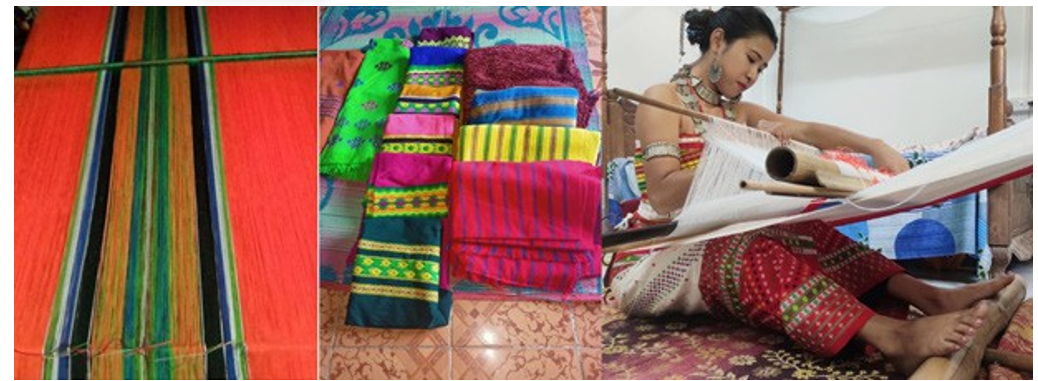
Fig. 1. Activity of Handloom Artisans in the rural areas
handloom activities. The socio-economic status of the surveyed rural villages of Darlong has been changing rapidly because of educational improvement and cultural assimilation as a result which time-honoured cultural elements especially traditional dresses particularly of men gradually being replaced by modern Western dress.
Avirami et al. 2017 has tried to understand the current scenario of the handicraft industry and the challenges faced by the artisans in India. The study is also for the technological gradation to capture more market values, to emphasis interest among the youth and to adopt internet technology to sell products through E-Commerce sites. Jain 2016, has studied the impact of government policies on the marketing strategy of handicrafts with special reference to 220 artisans who had participated in 12 trade fares held in Madhya Pradesh during the span of the study at different point of time. The study was concentrated on the role and performance of the Government concerning the upliftment of handicrafts and their respective policies and regulations. It was observed that design scheme, marketing support scheme, export scheme, publicity scheme, planning & research scheme, and marketing scheme were hardly recognized by the artisans.
Before taking a sincere attempt in that line, the situation arises a pertinent research question to answer:
Whether the existing economics of livelihood generations from the handloom by the rural people have the potential for socio-economic development through supplementary livelihood generation activity by taking any commercial venture?
Thus, against the present backdrop, we attempt to status of handloom artisans & marketing constraints in the Tripura, with specific objectives 1) to analyse the socioeconomic status of handloom and handicraft artisans; 2) to analyse the profitability of Handloom product; 3) to identify the challenges faced by handicraft artisans.
MATERIAL AND METHODS
The current study is descriptive and tries to understand the “socioeconomic status and issues faced by handloom and handicraft workers in West Tripura District, Tripura.” Both primary and secondary sources have been used to collect the data for this research work. The study was conducted in the region of sixteen villages in the Hezamara, Belbari, Mandai, and Lefunga rural development blocks of West Tripura district. A semi- structured schedule created specifically for the purpose was used to collect primary data from the respondents. The information was specially acquired by the researcher in the West Tripura villages. Semi-structured interviews that took place in the year 2023 were used to collect the information and to check the reliability of Cronbach’s Alpha was observed at 0.886. To accommodate the responders, who make up a sizable share and do not speak English, this scheduling method was used. A variety of secondary sources, including journals, articles, books, reports, websites, and so forth, were used to collect the data. Convenience sampling has been used by the researcher to gather data for the current study. Among the rural handcraft artisans, samples of 200 respondents are chosen for the study.
Likert Scale
To measure the respondent’s opinions on different constraints a Likert scale was used for scaling the attitudes of the respondents. In this survey respondents were asked to rate each item in terms of agreement or disagreement of the given statements. Here data collected are in the ordinal (ranking) according to priority by the respondent’s responses. Five is the highest possible score on the charts and one is the lowest. The responses elicited may be coded as 1-Strongly disagree, 2-Somewhat disagree, 3-Undecided, 4-Somewhat agree; 5-Strongly agree (Devore and Peak, 1992). The higher scores indicate more important and vice versa. Modal values were used to describe the response. The result gives different percentages across different attributes. The percentage towards each attribute indicates their opinion shares towards each problem.
Henry Garrett Ranking Method
The Garrett method is often used to complete the ranking of an alternative based on the ratings of respondents that are converted into certain ranks (Dhanavandan, 2016). This ranking is done by determining the most significant weakness of handloom artisans from their opinion.
The positioning of options utilizing the Garrett method is finished by computing the respondent’s information as a variable of the rate position esteem utilizing the following equation;

where, Rij is the rank given for the i variable by the jth respondents, while Nj is the number of variables ranked by jth respondents. The results of the percentage position are then converted into Garrett Values using the Garrett ranking conversion table.
RESULT AND DISCUSSION
Age is a determining factor in individual physical growth, mental maturity, decision-making, and physical and confidence level differs based on age. There are 200 respondents, of which 51.50 percent respondents belong to the young age group, 22 percent respondents belong to the Middle age group i.e. 35-45 years, and
26.50 percent respondents to the old age of above 45 years. It is concluded that the young age group of 18- 35 years are more engaged to the handicrafts work than of other groups. Middle age group of respondents are significantly influenced the artisan activity (Debbarma and Geetha, 2017).
In this context to the gender distribution in the artisan, it was observed that only 9 percent of respondents are male and 91 percent of respondents are female are engaged in handloom weaving, so it is referred from the above analysis that more females are involved in handicraft activities. The research area’s weavers’ participation in the activity is significantly influenced by gender.
The study revealed that out of 200 respondents, 75 percent of the respondents are married and 25 percent of the respondents are unmarried in the case of the living standard of the respondents in the study areas, it was found that 67.50 percent of the respondents belong to below poverty level (BPL) category, 25 percent of the respondents belong to above poverty level (APL) category and 7.50 percent belongs to Antyodaya category.
The educational status of the respondents in the rural areas is also shown. It explains that out of 200 respondents, 38 percent are illiterate, 20.50 percent are up to the primary level, 17.50percent are up to high school and 13 percent are up to the higher secondary level of education, 7.50 percent have the educational level up to graduation and only 3.50 percent had post- graduation. So it can be referred that only 11 percent of respondents in the study area have an education level up to the college/universities. Education plays a significant role as the majority of the respondents are literate (Debbarma, 2020).
There are 85 percent of the family belongs to the nuclear family and 15 percent of respondents belong to joint family only. On average 1.73 person is directly or indirectly involved in the handloom activity. They may have found it advantageous to have small families to lead a more comfortable and fulfilling life due to the small family standards they follow, their understanding of the costs of living, and the challenges associated with caring for large size families. (Debbarma, 2020).
The study also explains the awareness of the fair and exhibition of selected respondents. Out of that, only 37 percent are aware of the fair and exhibition and the rest of the 63 percent is not aware of the fair. The awareness about the fair and exhibition to the artisan
Table 1. Socioeconomic status of handloom weavers in West Tripura
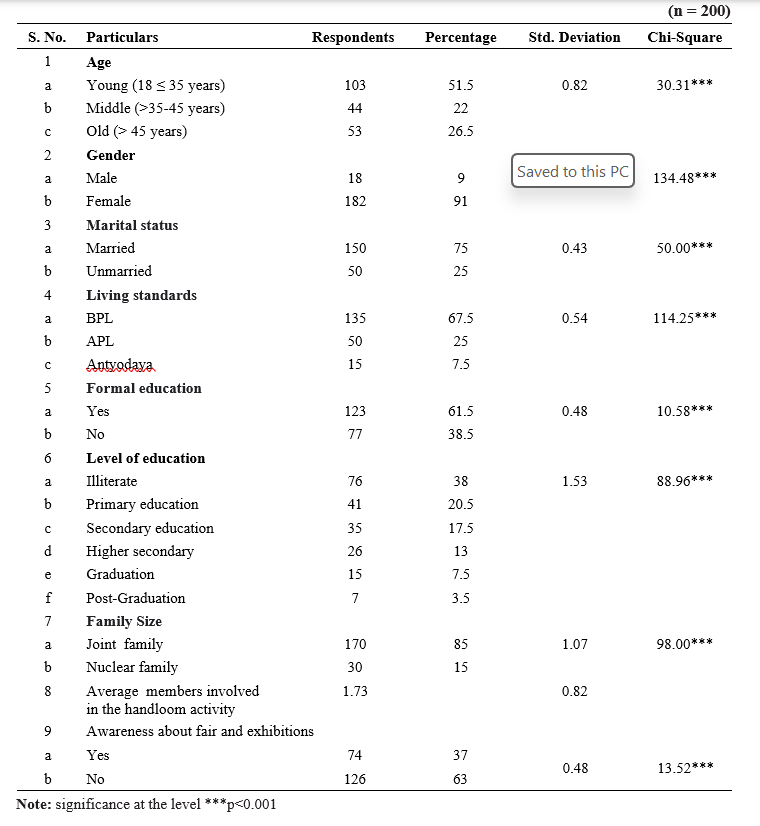
Table 2. Source of income of handloom weavers in West Tripura
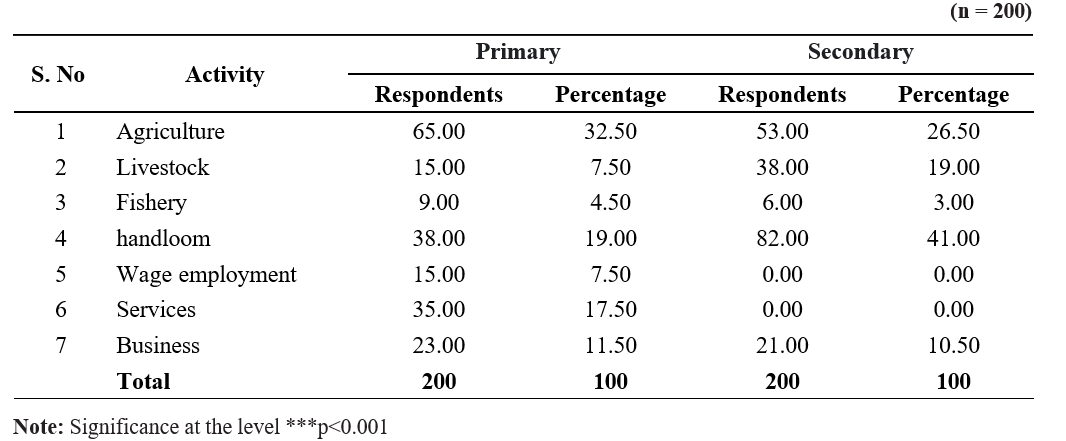
plays a significant role in the socioeconomic status of the respondents.
The above-mentioned table shows the primary and secondary sources of income of handloom weavers. Out of the total respondents, 32.50 percent state agriculture as their primary source of income whereas 26.50 percent consider agriculture as percent secondary source of income. 19.00 percent state handloom as their primary source of income whereas 41.00% consider handloom as a secondary source of income. 7.50 percent and 19.00 percent of respondents say livestock as a primary and secondary source of income respectively.
The above table 3 shows the experience in handloom activity of the respondents of the study area. Out of 200 respondents, 44 percent are having experience of 1-5 years. 4.50 percent of the respondents had less than 1 year of handloom experience, 19.00 percent had 5-10years of experience, 12 percent had 10-15 years of experience, 7.50 percent had 15-20 years, and 13.00 percent had More than 20 years of experience in handloom activity. Experience plays a significant role as the majority of the respondents are having experience of 1-5 years.
The above table 4 shows the income of the respondents in the study area. It states that 37 percent, of respondents have a monthly income below 10,000. Of the respondents 25 percent have a monthly income of between 10,001-20,000, 19.00 percent have a monthly income of 20,001-30,000, and 9 percent of the respondents are having a monthly income of 30,001 – 40,000. 6 percent have a monthly income of 40,001-
Table 3. Experience (years) in handloom activity

Table 4. Distribution of Respondents average monthly income

50,000 and 4 percent have a monthly income above 50,000 in the area. The monthly income of the artisan plays a significant role in their socioeconomic status.
All the respondents have been categorized into three categories:1) Running their own business 2) Doing service in some handicraft unit with a fixed salary and 3) Potential artisans doing handicrafts in their leisure time only.
It is noticeable that 132 artisans (66 percent) are in their own handicraft business either established by themselves or by family. 56 artisans (28 percent) are part- time artisans who are not currently employed regularly in the field of handicrafts. They are skilled people but not getting regular work in handicrafts. So, such artisans work in their leisure time to earn supplementary income. Some are employed in other occupations. And only 12 artisans i.e. 6 percent are engaged in service with fixed salary in some other handicraft business.
Table 5. Form of handloom activity by handloom weavers

It is clear from the above table that most of the respondents 85.50 percent do not have any membership but operate at the individual level. 10 percent of the artisans are a member of some Self-help-groups, while 1.50 percent is members of NGOs. And 3 percent of respondents registered in some other organization.
From the above-mentioned Table 7, it has been found that the majority of the artisans, i.e., 85 (42.50 percent) have joined this handicraft activity to utilize free time. Thus, such activity can be helpful to women artisans to utilize their leisure time in some creative and productive work which can add supplemental income to their family income. 27 numbers of respondents (13.50 percent) said that being easy to learn and to do; they have accepted such handicrafts, while 53 numbers of respondents (26.50 percent) had no other option than handicrafts. Only 3 respondents, 1.50 percent respondents have been inspired to come into this field by the government’s efforts and help. Thus, the reach of government initiatives seems weak and must be focused more. Being a less investment demanding activity, 16.00 percent of people have been motivated to start it.
The economic feasibility indicators of handloom artisans are presented in Table 8. The average B-C ratio
Table 6. Membership category of handloom weavers

was estimated at 2.14:1. The B-C ratio analysis indicates that the investment in handloom is economically viable and on average Rs 1 investment brings Rs 2.14 returns. Handloom activity is capital intensive. It was found to be economically feasible in the state.
Garrett ranking technique has been used to analyze the factors influencing the handloom by the respondents. The respondents were asked to rank the eight factors identified for this study from 1 to 8 to know their preference in the selection of constraint. The calculated percentage position for the rank 1 to 8and their correspondent Garrett’s table as shown in Table 9, For factors, the total score is calculated by multiplying the number of respondents ranking that factor as 1 to 8.
Based on the ranks assigned by the sample respondents, the various challenges/constraint experienced by the handloom weavers in the study area are analyzed through Garret Ranking Techniques,
Table 7. Reasons to join the handloom

It is evident from the above table reveals that the less information about Market and Marketing (71.46), was the main constraint experienced by the handloom weavers followed by the Scarcity of Working capital / Financial problems (70.92), Lack of information about government aid/credit facilities (69.88), Lack of modern managerial skills (66.55), Problems due to less education (56.72), Lack of knowledge about latest designs/current market demands (54.77), No information about exports (46.58), Lack of organized identity (42.96).
Table 8. Economics of Handloom Activity (Rs/year)
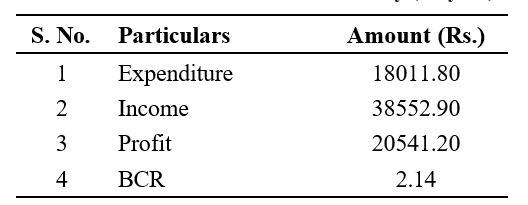
Table 9. Percentage positions and their corresponding Garetts table values

The artisans shared their own experiences when asked or the challenges faced by them in this field. The above-mentioned table shows the mean and standard deviation of constraints faced by the selected handloom Weavers. As can be seen from the table that the mean of almost all the constraints is more than point 3, hence all the constraints are crucial for the respondents. The challenges of ‘Competition with latest machine-made products of large industries’ and ‘Lack of infrastructural facilities’ and ‘High marketing cost’ are also important constraints. They told that they have to face competition from the latest machine-made products produced on a large scale in big industries, as they are cheap, identical, and fast to be produced; besides such artisans feel that there is the improper implementation of government schemes and programs though such programs seem attractive at planning and policy level. Most of the respondents told that there is less gain as compared to hard work. They feel that it is laborious work not having social status, as gain is very less as compared to time spent and energy invested in it.
Table 12 indicates the Component wise distribution of different constraints faced but handloom artisans in the study area. It shows that there are 8 particulars under Production techniques and interest component viz. decreasing demand due to change in the taste & interest of people, handicraft is losing its original form due to changes in lifestyle and culture, competition with latest machine made products of large industries, problems of quality and durability due to handmade, gain is less as compared to hard work, new generation is not interested in handicrafts, lack of infrastructural facilities, lack of raw materials. Under Government regulation & intervention component there are 2 factors viz. improper implementation of government schemes/ programmes, irregularity in employment. And under Lack of marketing functions & infrastructure component there are 4 factors viz., middlemen earn huge profit, high marketing cost, lack of marketing linkage, price fluctuation (Abebe, 2016).
According to the study, all of Tripura’s handloom weavers come from the state’s indigenous communities, which are entirely controlled by women. The majority of women working in the handloom industry are members of Tripura’s tribal community who live in rural regions. The handloom industries have primarily or secondarily given the rural women’s population work options. Production techniques and interest, government regulation & intervention, and lack of marketing functions & infrastructure are being severely challenged to the rural handloom weavers. Artisans mostly work in traditional and unorganized sector in which they are vulnerable to exploitation and low wages. It finds that the artisans are unaware about the schemes and also due to lack of training facilities quality of the products could not meet the tasteof theconsumer in the towns and cities. To address the issues facing the weavers, it is vital to move forward.
RECOMMENDATION
The need of the hour is urgent reforms and upgrades to ensure sustainability andlongevity for artisans at the grassroots level. This is a generational skill but we can findthat there is lack of income as most of the respondent
Table 10. Ranking constraint associated to handloom weavers
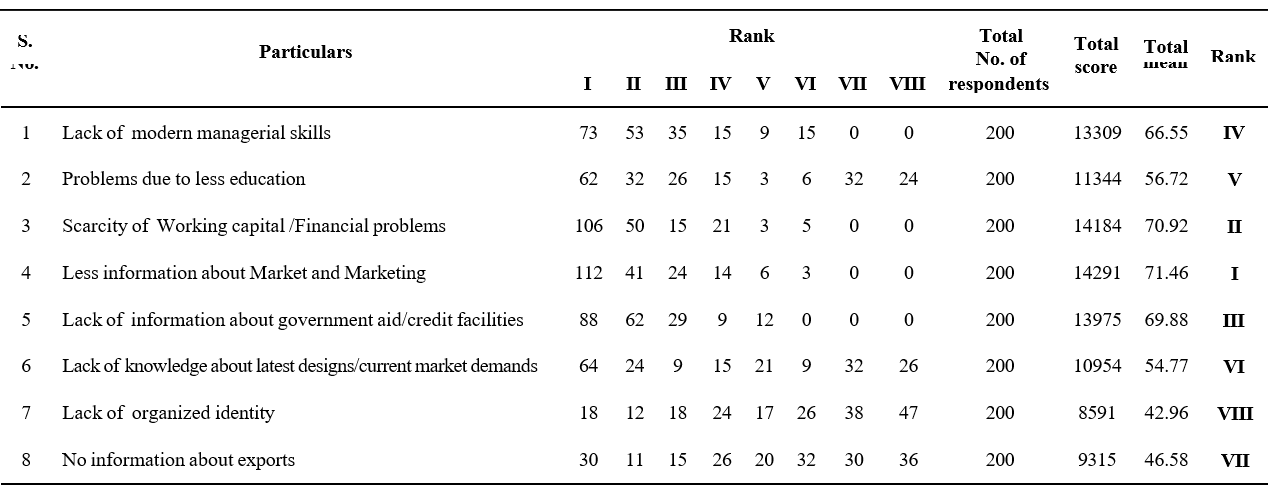
Table 11. Constraints faced by the selected handloom weavers
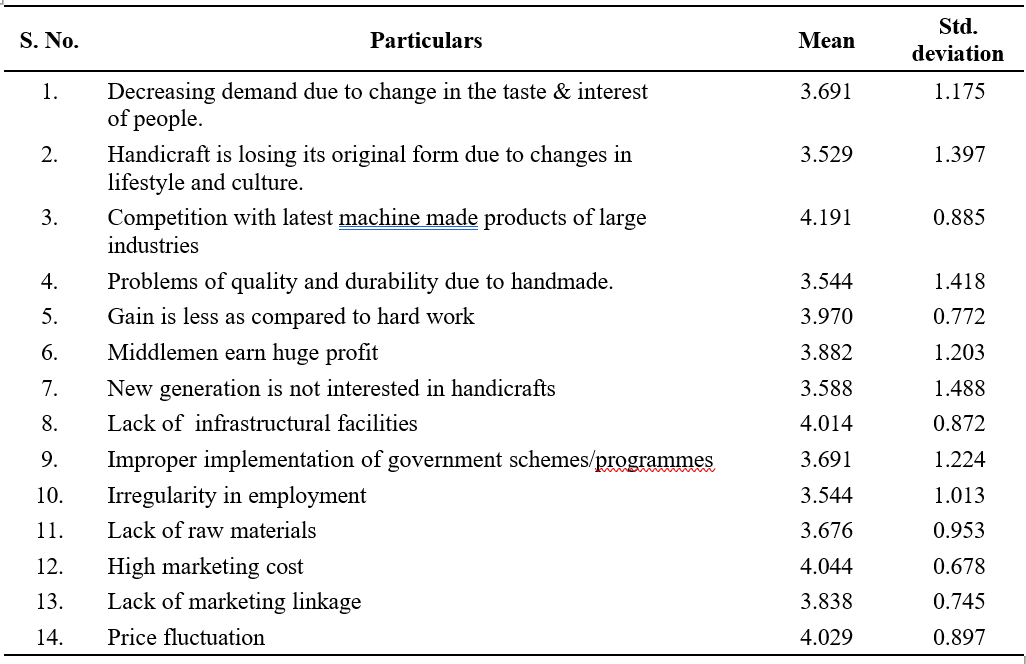
belongs to BPL category. Theawareness regarding various government schemes are to be created among the artisanso that that find better sources of financial help. The academic researchwill not be enough to create confidence among the handloom workers. Though oursample size reveals that young generation are involved in the handloom industry it hasalso highlighted that most of them are carrying it as their part time activity since they donot have others engagement. Most of the respondent feels that the work is laboriouswithout any social status. Thus we can realize that absences of dignity of labour aredeterring the current generation from entering the industry in a full-fledged manner andthus they are not taking this business seriously. Government and local bodies shouldtake a serious note of it. Lack of marketing facilities is also becoming a constraint forthese artisan. The problems are multi layered. Despite multiple bodies, governmentschemes and funds geared at holistic change, long-term benefits don’t trickle down tothe artisans. For the women workforce and the immediate concern is hygienic workingconditions with washrooms, natural light and airflow for them. We need to improve theinfrastructure and make it aspirational. Further, both at the governmental and privatelevel, regular gathering of statistical information is required to understand the realsituation on ground with regards to production, markets and quality. This can be furtherleveraged for the creation of policies as well as local and national organisations whichcan stand for the handloom sector.
ACKNOWLEDGEMENT
We thank the respondents for their unconditional support and cooperation during data collection. We are also grateful to the ICFAI University Tripura for constant support during the study work and anonymous reviewers for the constructive feedback and helpful comments that improved the study substantially.
Table 12. Component wise distribution of different constraints

LITERATURE CITED
Abebe, G.K., Bijman, J and Royer, A. 2016. Are middlemen facilitators or barriers to improve smallholders’ welfare in rural economies? Empirical evidence from Ethiopia. Journal of Rural Studies. 43: 203-213.
Avirami, P. 2017. Indian Handicrafts and its Challenges faced by Artisans Community. International Journal of Economic Research. 14(7): 431-438.
Debbarma, A and Geetha, V.J. 2017. Problems of Women Handloom Entrepreneurs in West Tripura District, Tripura. International Journal of Law, Humanities and Social Science, 1(6) 68-80.
Debbarma, S. 2020. A Study on the socio economic status of rural handicraft artisans in Hezamara RD block west Tripura District, Tripura. M.Phil. Dissertation Submitted to the Annamalai University, Tamil Nadu, India.
Debbarma, S and Murugesan, P. 2022. A Study on the status of rural handicraft artisans in Mandwi RD Block, West Tripura District, Tripura. Journal of Pharmaceutical Negative Results. 13(2): 1292- 1297.
Devore, J.L and Peck, R. 1993. Statistics: The exploration and analysis of data 2nd edition Duxbury Press (Belmont, Califonia).
Dhanavandan, S. 2016. Application of garret ranking technique: practical approach. International Journal of Library and Information Studies. 6(3): 135-140.
Ganguly, A. Gokhale, Y and Gadgil, M. 2003. Developing responsive indicators for the Indian biosphere reserve programme. Journal of the Bombay Natural History Society. 100 (2-3): 214-225.
Jain, R. 2016. A study of the impact of government policies on marketing strategy of handicrafts. Ph.D. Thesis Submitted to the Devi Ahilya Vishwavidyalaya, Indore, India.
Narzary, J. 2013. Marketing problems and prospects of handloom and handicrafts industry in BTAD. Global Research Methodology Journal. 2(7).
Patil, N.U. 2012. Role of handloom industry in India. International Indexed & Referred Research Journal. 4: 1-2.
Roy T. 2002. Acceptance of innovations in early twentieth century Indian weaving. The Economic History Review New Series. 55(3): 507-532.
Roy, S., Debbarma, D., Darlong, S and Mitra, S. 2018. Livelihood of traditional handloom weavers of darlong community in Unakoti District of Tripura, India. Geographic, 13(1): 35-47.
Shah, A and Patel, R. 2016. E-commerce and Rural Handicraft Artisans. Voice of Research. 5: 24-29.
Shah, A and Patel, R. 2017. Problems and challenges faced by handicraft artisans. Voice of Research. 6(1): 57-61.
Tanusree, S. 2015. A study of the present situation of the traditional handloom weavers of Varanasi, Uttar Pradesh, India. International Research Journal of Social Sciences. 4(3): 48-53.
- Effect of Foliar Application of Nano Urea on Growth and Yield of Fodder Maize
- Studies on Effect of Antibiotic on Biological Parameters Of Diamondback Moth, Plutella Xylostella (Linnaeus)
- Estimation of Genetic Variability for Yield and Yield Attributing Traits in Sesame (Sesamum Indicum L.)
- An Economic Analysis of Community Hiring Centres (Chcs) in Chittoor District of Andhra Pradesh
- Development and Validation of Gc-Ecd Method for Determination of Profenophos in Pigeonpea
- Assessment of Soil Major Nutrients in Scarce Rainfall Zone of Andhra Pradesh

